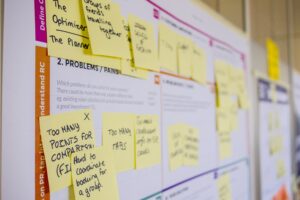It is crucial to ensure that your customer discovery questions asked are neutral and unbiased. Bias can affect the quality of data collected, leading to erroneous findings and misguided decisions. This article explores the different types of bias in customer discovery, its impact on research outcomes, and techniques for reducing bias. We will also provide techniques for conducting unbiased customer interviews and analyzing responses.
Understanding Bias in Customer Discovery
Bias refers to a tendency or preference towards a particular point of view, result, or outcome that may distort the collected data. It can present itself in different forms, ranging from the questions asked, sample selection, interviewer’s tone, or analysis of results. Understanding these biases and their impact is critical when crafting neutral and unbiased questions.
When conducting customer discovery, it is important to be aware of the potential biases that can arise. These biases can have a significant impact on the accuracy and validity of the data collected, which can ultimately affect the success of the product or service being developed.
Types of Bias in Customer Discovery
Some of the biases that can occur in customer discovery include:
- Confirmation bias: This occurs when an individual seeks only information that confirms their existing beliefs and assumptions. This can lead to a narrow focus and a lack of consideration for alternative viewpoints.
- Selection bias: This occurs when the sample population selected is not representative of the intended audience, leading to skewed results. For example, if a survey is only distributed to a specific demographic, the results may not accurately reflect the opinions of the broader population.
- Response bias: This occurs when respondents provide inaccurate or incomplete information either due to social desirability or perceived anonymity. For example, a respondent may provide answers that they believe are socially acceptable, rather than their true opinions.
The Impact of Bias on Research Outcomes
The impact of bias on research outcomes can be significant. Bias can lead to:
- Misinterpretation of data: When biased data is analyzed, it can lead to incorrect conclusions and misinterpretation of the results.
- Wrong conclusions: Bias can lead to the wrong conclusions being drawn from the data, which can ultimately affect the success of the product or service being developed.
- Poor decision making: If the data collected is biased, it can lead to poor decision making and a lack of understanding of the true needs and wants of the target audience.
- Loss of trust: Bias can also affect the credibility of a study, leading to a loss of trust in the research, the organization conducting it, or the products and services on offer.
Therefore, it is essential to take steps to minimize bias in customer discovery. This can include using neutral language, selecting a representative sample population, and analyzing the data objectively. By doing so, organizations can ensure that the data collected is accurate, reliable, and actionable, ultimately leading to the development of successful products and services that meet the needs of their target audience.
Crafting Neutral and Unbiased Customer Discovery Questions
To reduce bias when crafting questions, it is essential to use neutral language, open-ended questions, and avoid leading questions.
The Importance of Open-Ended Questions
Open-ended questions allow the respondents to provide detailed and diverse answers to the questions asked. This approach promotes natural and unbiased responses, providing valuable insights into customer needs, preferences, and expectations. Examples of open-ended questions include; “Can you tell me more about your experience with our product?” or “What are your thoughts about X feature?”
Avoiding Leading Questions
Leading questions, also known as suggestive questions, push the respondent towards a specific response or point of view. These questions can limit respondents’ answers, leading to a biased result. For instance, a question like, “How much do you like our product?” presupposes that the respondent likes the product, leading to an affirmative and biased response. Instead, a neutral question like, “What are your thoughts on our product?” is less suggestive and promotes more honest answers.
Using Neutral Language
Neutral language refers to using words and terms that do not express favoritism or opinion towards specific responses. Using neutral language helps participants feel more comfortable and allows them to express their thoughts without feeling judged. For example, instead of saying, “Our product is the best in the market,” say, “What are your thoughts on our product and how it compares to others in the market?”
Techniques for Reducing Bias in Customer Discovery
Reducing bias in customer discovery requires the proper use of research techniques and sampling methodologies. The following techniques can help reduce bias in customer discovery.
Random Sampling
Random sampling ensures that the participants selected for the research are representative of the group being studied. By using a random selection process, researchers can reduce bias in sample selection, leading to accurate descriptions of the study population.
Triangulation of Data Sources
Triangulation refers to the use of multiple data sources to verify research findings. This process ensures that the collected data is consistent, reliable, and accurate across multiple sources.
Blind Testing
Blind testing refers to keeping the participants in the dark about the desired outcome of the research. This technique reduces response bias by promoting natural and unbiased responses from the participants.
Conducting Unbiased Customer Interviews
Unbiased customer interviews require proper preparation, active listening, and careful analysis of responses. The following section provides techniques for conducting unbiased customer interviews.
Preparing for the Interview
The interviewer should familiarize themselves with the research goals, questions, and objectives. They should also ensure that the interview guide is unbiased and neutral. Preparing for the interview helps reduce the likelihood of interviewer bias and ensures that respondents are getting the appropriate information.
Active Listening and Probing Techniques
Active listening involves paying attention to what the respondent is saying and not saying. Probing techniques involve asking more questions to clarify and get more information about a respondent’s response. These techniques promote natural and unbiased responses by allowing the respondents to express their thoughts freely.
Analyzing and Interpreting Responses
After the interview, it is essential to analyze and interpret the responses without any pre-existing biases or assumptions. The interviewer should look for themes, patterns, and common responses. Analyzing the responses in this manner allows for unbiased and objective interpretation of results.
Conclusion
Bias in customer discovery can lead to erroneous findings, wrong conclusions, and poor decision making. It is essential to craft neutral and unbiased questions, use proper research techniques, and conduct unbiased interviews to reduce bias. Being aware of biases and their impact on research outcomes is crucial in designing and conducting unbiased research for informed decision making.
When conducting customer discovery, it is crucial to ensure that the questions asked are neutral and unbiased. Bias can affect the quality of data collected, leading to erroneous findings and misguided decisions. This article explores the different types of bias in customer discovery, its impact on research outcomes, and techniques for reducing bias. We will also provide techniques for conducting unbiased customer interviews and analyzing responses.
Understanding Bias in Customer Discovery
Bias refers to a tendency or preference towards a particular point of view, result, or outcome that may distort the collected data. It can present itself in different forms, ranging from the questions asked, sample selection, interviewer’s tone, or analysis of results. Understanding these biases and their impact is critical when crafting neutral and unbiased questions.
When conducting customer discovery, it is important to be aware of the potential biases that can arise. These biases can have a significant impact on the accuracy and validity of the data collected, which can ultimately affect the success of the product or service being developed.
Types of Bias in Customer Discovery
Some of the biases that can occur in customer discovery include:
- Confirmation bias: This occurs when an individual seeks only information that confirms their existing beliefs and assumptions. This can lead to a narrow focus and a lack of consideration for alternative viewpoints.
- Selection bias: This occurs when the sample population selected is not representative of the intended audience, leading to skewed results. For example, if a survey is only distributed to a specific demographic, the results may not accurately reflect the opinions of the broader population.
- Response bias: This occurs when respondents provide inaccurate or incomplete information either due to social desirability or perceived anonymity. For example, a respondent may provide answers that they believe are socially acceptable, rather than their true opinions.
The Impact of Bias on Research Outcomes
The impact of bias on research outcomes can be significant. Bias can lead to:
- Misinterpretation of data: When biased data is analyzed, it can lead to incorrect conclusions and misinterpretation of the results.
- Wrong conclusions: Bias can lead to the wrong conclusions being drawn from the data, which can ultimately affect the success of the product or service being developed.
- Poor decision making: If the data collected is biased, it can lead to poor decision making and a lack of understanding of the true needs and wants of the target audience.
- Loss of trust: Bias can also affect the credibility of a study, leading to a loss of trust in the research, the organization conducting it, or the products and services on offer.
Therefore, it is essential to take steps to minimize bias in customer discovery. This can include using neutral language, selecting a representative sample population, and analyzing the data objectively. By doing so, organizations can ensure that the data collected is accurate, reliable, and actionable, ultimately leading to the development of successful products and services that meet the needs of their target audience.
Crafting Neutral and Unbiased Customer Discovery Questions
To reduce bias when crafting questions, it is essential to use neutral language, open-ended questions, and avoid leading questions.
The Importance of Open-Ended Questions
Open-ended questions allow the respondents to provide detailed and diverse answers to the questions asked. This approach promotes natural and unbiased responses, providing valuable insights into customer needs, preferences, and expectations. Examples of open-ended questions include; “Can you tell me more about your experience with our product?” or “What are your thoughts about X feature?”
Avoiding Leading Questions
Leading questions, also known as suggestive questions, push the respondent towards a specific response or point of view. These questions can limit respondents’ answers, leading to a biased result. For instance, a question like, “How much do you like our product?” presupposes that the respondent likes the product, leading to an affirmative and biased response. Instead, a neutral question like, “What are your thoughts on our product?” is less suggestive and promotes more honest answers.
Using Neutral Language
Neutral language refers to using words and terms that do not express favoritism or opinion towards specific responses. Using neutral language helps participants feel more comfortable and allows them to express their thoughts without feeling judged. For example, instead of saying, “Our product is the best in the market,” say, “What are your thoughts on our product and how it compares to others in the market?”
Techniques for Reducing Bias in Customer Discovery
Reducing bias in customer discovery requires the proper use of research techniques and sampling methodologies. The following techniques can help reduce bias in customer discovery.
Random Sampling
Random sampling ensures that the participants selected for the research are representative of the group being studied. By using a random selection process, researchers can reduce bias in sample selection, leading to accurate descriptions of the study population.
Triangulation of Data Sources
Triangulation refers to the use of multiple data sources to verify research findings. This process ensures that the collected data is consistent, reliable, and accurate across multiple sources.
Blind Testing
Blind testing refers to keeping the participants in the dark about the desired outcome of the research. This technique reduces response bias by promoting natural and unbiased responses from the participants.
Conducting Unbiased Customer Interviews
Unbiased customer interviews require proper preparation, active listening, and careful analysis of responses. The following section provides techniques for conducting unbiased customer interviews.
Preparing for the Interview
The interviewer should familiarize themselves with the research goals, questions, and objectives. They should also ensure that the interview guide is unbiased and neutral. Preparing for the interview helps reduce the likelihood of interviewer bias and ensures that respondents are getting the appropriate information.
Active Listening and Probing Techniques
Active listening involves paying attention to what the respondent is saying and not saying. Probing techniques involve asking more questions to clarify and get more information about a respondent’s response. These techniques promote natural and unbiased responses by allowing the respondents to express their thoughts freely.
Analyzing and Interpreting Responses
After the interview, it is essential to analyze and interpret the responses without any pre-existing biases or assumptions. The interviewer should look for themes, patterns, and common responses. Analyzing the responses in this manner allows for unbiased and objective interpretation of results.
Conclusion
Bias in customer discovery can lead to erroneous findings, wrong conclusions, and poor decision making. It is essential to craft neutral and unbiased questions, use proper research techniques, and conduct unbiased interviews to reduce bias. Being aware of biases and their impact on research outcomes is crucial in designing and conducting unbiased research for informed decision making.








